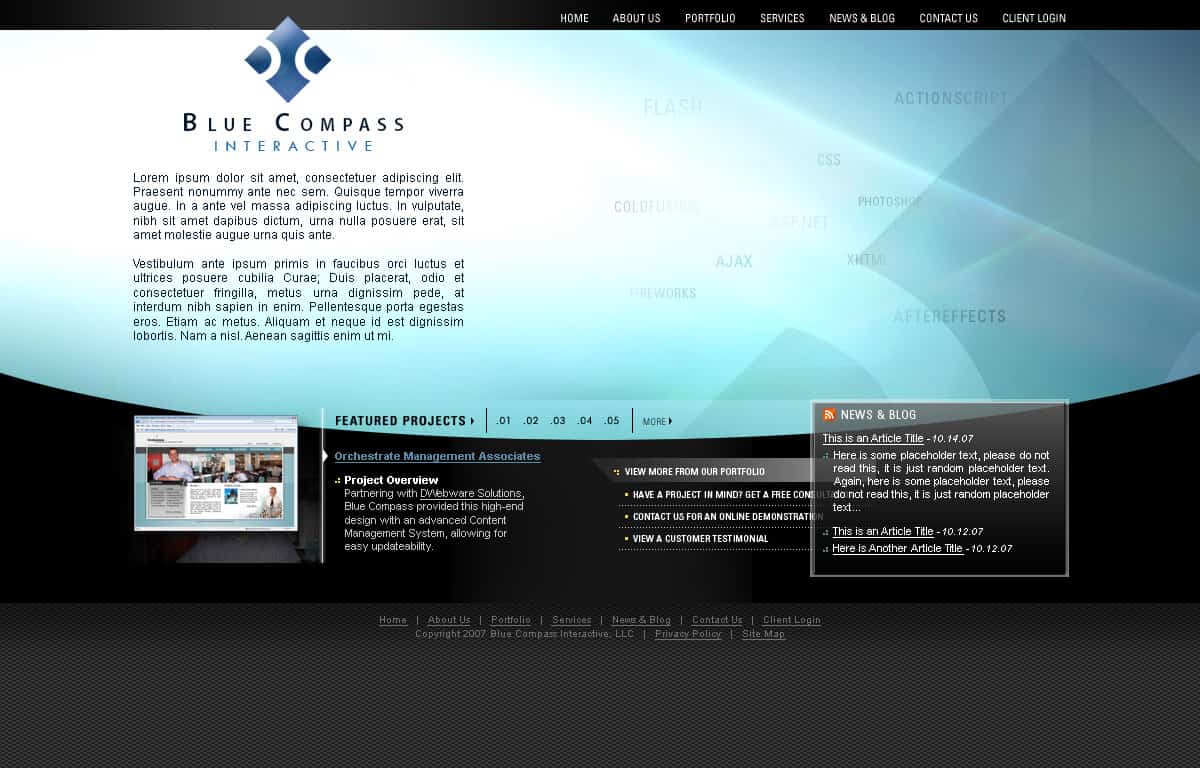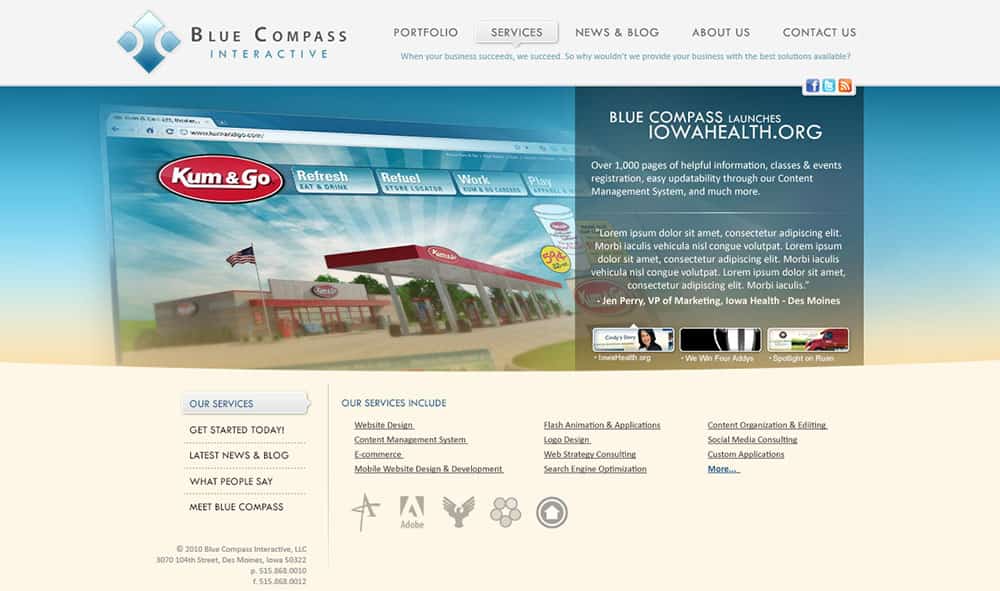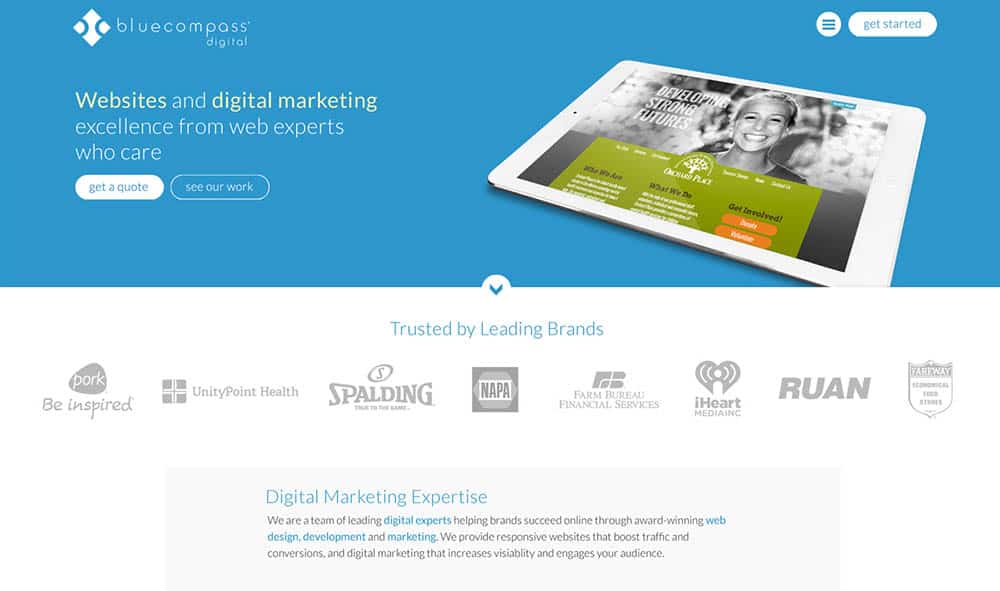April 22, 2024
Drew Harden
SEOUser ExperienceSocial MediaDigital MarketingWeb DesignWeb DevelopmentBlue Compass Culture
The Impact Of Digital Technology That Shape Blue Compass & Society
Take a moment to create a mental inventory of all the ways your digital technology impacts your day. If a device, website, app or social media platform was to disappear tomorrow, how would that impact your life?
In honor of Blue Compass’ 15th anniversary, and because we love to geek out over all things digital, our experts are taking a look at how the ever-changing digital landscape over the last 15 years has impacted society, including businesses, and how digital evolution helped shape Blue Compass.
What Was The Digital Era Like In 2007?
Let’s set the scene for 2007, the year Blue Compass was founded. Known as the “tipping point of the world’s digital journey,” 2007 was a year full of seismic shifts within the digital realm. Prior decades had steadily built technology that helped to streamline business practices, but nothing can compare to the innovative nature of ‘07. Check out a handful of major tech advances and breaking headlines from the digital technology of that year:
- Apple forever redefined the smartphone with the release of the iPhone. Wearing jeans and his iconic black mock turtleneck, Steve Jobs announced the iPhone on January 9, 2007, calling it “a revolutionary and magical product that is five years ahead of any other mobile phone.”
- The idea of using a hashtag was born. X (formerly known as Twitter) users began utilizing the # symbol to group tweets about a related topic and find others who were tweeting about the same thing.
- Zuckerberg decided not to sell Facebook to Yahoo. Instead, he opened up the Facebook membership beyond students, creating the idea of an online personal profile.
- “Cloud computing” took hold in the language of technology.
- Google’s classic ten-link results page got a major update in 2007 as they rolled out Universal Search, which integrated results from all Google verticals. This allowed search results to include images, maps, products and more on one page, instead of requiring users to switch to different tabs.
It’s safe to say our co-founders, Cary and Drew, started Blue Compass in a truly transformative year. Our company’s journey began with web design and development, but as the digitalized world around us quickly unfolded, our business offerings expanded.
The Digital Evolution Of Web Design, Development And User Experience
When Blue Compass started, web design and development were separate entities working toward a common goal: a website. Over the last 15 years, our team has witnessed the impact of digital technology with the design and development holistically coming together and even developing a cohesive partnership with digital marketing. Because web design and development work in unison with one another, the functionality and the user experience of websites have evolved from slow and siloed to fast and seamless.
In reference to web design in Blue Compass’ early years, our CFO, Cary said, “Drew and I would design within Photoshop and have hundreds of layers to achieve a complex and unique homepage design. Now we build layouts to blend speed, conversions and first and foremost, branding.”
2000s Website Design Trends That Take Us Back
As exciting as it is to predict how websites will evolve with the needs of society and advancements within the digital industry, it is equally as fun to appreciate how websites have evolved with us over the years.
Web 2.0 Designs. When Blue Compass began in 2007, our main web design style was "web 2.0.” This consisted of a very colorful, gradient-heavy look and the text font was small. Some of the prevalent web design elements of that time were reflections, bevels and shadows, and the buttons had a reflective, gel look.

Large, oversized footers. In general, 2010 consisted of exaggerated headings and images, and the footer was no exception. As websites evolved to mimic print material, it only made sense to make sure every element of a website was easily visible and accessible. Was this trend a good one? You can be the judge of that, but a rich footer is a great way to house valuable links and information about the company.

Rise of minimalism. As mobile sites became increasingly popular and a part of the average person’s every day life in the late 2000’s, the pressure for websites to respond to screen sizes increased. Minimalism design began to rise within the digital community because with less content and more white space, the transition from desktop to mobile versions was smoother. Minimalist websites ensured greater chances of translating into beautiful mobile versions.

Design for the user experience. The term user experience, or UX, came from an Apple cognitive scientist, Donald Norman, in the mid 90s. Over the years, web developers and designers shifted toward building software, websites and apps around meeting the needs of those who will use them. Skilled UX designers and developers can anticipate how a consumer will respond and interact with a site, and they know if they create a positive user experience, the higher chance the website has at paving a path to customer loyalty. In order to achieve a high-quality user experience on an app or website, there must be a seamless blend between engineering, marketing, graphic design and interface design. Sure, a site’s aesthetic is important, but the design elements associated with contributing to a positive experience can make it or break it. In recent years, Blue Compass always keeps the user in mind when crafting effective web designs for our clients.
Creating Websites For Mobile Use In A Digitalized World
Not only did the iPhone disrupt the cellphone industry in the digital era of 2007, it completely reinvented access to the internet with the inclusion of the Safari web browser.
Until this point, web designers and developers had been creating websites for desktops using applications like Flash and Web 2.0. By November 2007, 1.4 million people had purchased the iPhone, which meant the internet was now in over a million pockets. The puzzle for web developers over the next few years was to figure out a way for sites, and all elements like images, to respond to the difference in screen size.
Our co-founders, Drew and Cary, remember discussing the opportunity to create mobile versions of clients' websites. Drew Harden, our President, said:
“We did a number of experiments at first—the designs were very simple and the mobile websites were completely separate from the full desktop site. But, in 2009, we made mobile versions of every website we developed as an essential part of our process.”
Blue Compass went from building systems that ran independently from their desktop counterpart to a complete solution that catered to the audiences’ experience on their preferred device.
When Did Responsive Web Design Start?
By 2010, responsive web design ensured that a website could be created to fit all screen sizes and in all browsers, regardless of the device. As society stepped into the mobile-first era, this type of web design was vital for businesses if they wanted to show up in search results. Google announced mobile-friendliness as a ranking factor back in 2015, and they now index the mobile version of a website first when determining search rankings.
Quick “Flash” Back
Fifteen years ago, Flash was all the rage. This software created animations, applications and games for web browsers, and nearly all online animations and videos were in the Flash format.
In the late 2000s, Blue Compass heavily used Flash, with some websites completely created in Flash. But in 2010, Flash faced a huge blow when Apple's Steve Jobs decided iPhones would not support the technology due to security issues. Flash quickly began to decline in use, and the Flash Player was discontinued in 2020.
Icon-ic Skeuomorphic

We can’t discuss the iPhone without reminiscing on the life-like icon buttons. When the iPhone first launched, experts at Apple thought users would feel more comfortable clicking buttons that looked “real.” This 3D, shadow-focused design was called skeuomorphic. As time went on and society became more familiar with touching buttons on a screen, Apple decided to ditch the skeuomorphic elements upon the launch of the iOS 7 in September 2013 and shifted towards flat design.
The Digital Evolution Of Search Engine Optimization
When we began in 2007, we focused solely on launching websites and offered no search engine optimization (SEO) services. In 2009, however, we realized websites are like machines — with continual maintenance and support, the performance of the site will increase. Our team quickly started to embrace SEO and began building a robust, ongoing SEO process. As you probably know, Google is arguably responsible for shaping the internet as we know it today. The search engine is essentially a virtual library; if someone wants an answer to a question, they “Google it!”
Google is not just a search engine, though — Google is its own empire. In just a quarter of a century, the company has created products that shape our everyday routines: Chrome, Google Maps, Gmail, Google Drive, Google Analytics , Google Ads, Google Meet, Google Home and much more. These apps and products have altered long-hand business practices and encouraged organizations to operate, advertise and report in a digitized fashion.
To top it off, not only has Google changed the game, they’re always changing the rules! Google keeps us on our toes here at Blue Compass. Updates to their algorithm, changes to their platforms and new platforms occur on a regular basis, and our digital experts prioritize staying up-to-date on all of Google's improvements.
Social Media Throughout The Digital Eras
The digital scape is an ever-changing environment, and social media is just that. Social media has come a long way since 2007, evolving from a great tool to connect with friends and family through short status updates to becoming a whole host of opportunities for businesses and creators to sell products and interact with their target market.
In 2008 and 2009, Blue Compass began offering social media marketing, one of the first endeavors for our team being a Myspace marketing project for a band. As time went on, our team began consulting with our clients to optimize their social media profiles, creating content calendars that housed social campaigns and specific posting dates, and running their entire social media presence in many cases.
Early on, we focused mainly on Facebook, Twitter and Foursquare, with Myspace being the most popular platform at the time. In 2011, our team members heavily used Google+ and even created strategies for clients for a number of years since we’re an SEO-first agency, and Google always has new tools for marketers to utilize. In early 2013, we began using Twitter's short-form video platform, Vine, and helped a number of clients with their Vine presence. In total, we've provided social media marketing services on the following platforms over the years: Facebook, Twitter, Instagram, LinkedIn, TikTok, Snapchat, Pinterest, Google+, Myspace, Foursquare and Vine.
Social media has experienced many fluctuations within society over the last 15 years due to changes in trends, attention spans and advancements of mobile screens. But for businesses, social media channels are a no-brainer when it comes to getting in front of their audience. In a study by Statistica, daily time spent on social media platforms increased from 90 minutes in 2012 to 145 minutes in 2021. Social profiles are now like a second website for businesses and an extension of their brand for consumers to learn more about who they are and what products they offer. Through images, videos, links and captions, businesses can curate a whole online personality.
Want To Grow Your Business Using Today’s Digital Technology? Blue Compass Experts Are Here To Help
It’s safe to say that since 2007, Blue Compass has experienced many changes. We’ve come a long way in general terms of digitally functioning on a day-to-day basis. Second to reminiscing on the growth of our business and the digital industry as a whole, it has been a pleasure to grow alongside companies and historical tech events that change what services we offer, how we operate as a business and how our team lives their lives outside of the workplace.
With every iOS update, Google roll-out, web design trend and new social platform, society’s digital evolution and expectations continue to change. As the digital environment evolves and society adjusts, the opportunities for businesses to grow and interact with their target market advance. Our experts are here to help you and your business navigate this ever-changing, exciting digital environment. Contact us for web design and development needs or for your next SEO audit.